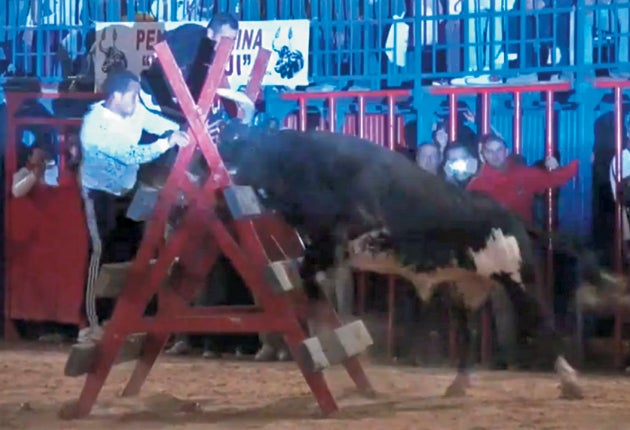Bloodthirsty revellers rush to see Mouse, the 550kg raging bull
After killing three people, Ratón is the star attraction. Mike Elkin reports from Madrid

For more than a century, Spaniards have killed bulls in the ring as part of the country's "national fiesta". One bull is fighting back and not taking prisoners. On Saturday night in Xàtiva, near Valencia, a bull named Mouse killed a 29-year-old man at a festival in which revellers enter the ring with the bulls, taunt them and try to avoid them as they charge. The victim had been drinking, according to press reports.
The man's death would be labelled an accident and likely forgotten if not for the bull that killed him. The 10-year-old Ratón, a 550kg bull, has now killed three people and injured dozens over the past five years. As a result, Ratón, which means "mouse" in Spanish, sells out festivals and hundreds of thousands watch his YouTube videos.
"He is a killer," Jesús Esteve, who faced Ratón once, told El Pais newspaper. "He waits for you to make a mistake and then he wallops you. And he doesn't let up."
Although calls and an email to Ratón's owner, former bullfighter Gregorio de Jesús, were not answered, it has been reported that he charges up to ¤10,000 (£8,800) per appearance, five times the normal price. Festival organisers, however, are happy to pay because they know they can boost ticket prices and still sell out. Everyone wants to see the killer bull. There are even groups of men who follow Ratón from fiesta to fiesta to face him and try to survive.
"People want to see danger," said Mariano Aguirre, president of the Royal Spanish Bullfighting Federation. "I wouldn't go near Ratón, but there are people in the Valencia region who treat this like a religion. The tradition is passed down from grandfather to father to son. But authorities should be careful about who is allowed into the ring, because most of the people killed or injured have been drinking, haven't slept much, or think that they are younger than they actually are."
His first kill, a 54-year-old man, came in 2006 in Puerto de Sagunto. The town brought Ratón back the next year.
But this morbid fascination that has made Ratón a star could prove to be a further blight on bull-related festivities. "This is symptomatic of bullfighting in general over the last 20 years, which is that despite all the talk of culture and art, what people want to see is danger and blood," said Alessandro Zara, spokesman for the Equanimal Foundation, a Madrid-based animal rights group. "And using this bull over and over again is even more dangerous, because the bulls learn. That is why in many places it is forbidden to use bulls more than once."
The presence of bulls in local festivals, from the small pueblos to the massive runs or encierros in Pamplona, is as omnipresent in a Spanish summer as the heat.
There are roughly 22,000 running of the bulls each year, and even more bull-related activities. The so-called recortes take place in a bullring, often with obstacles such as wooden stairs or platforms in the middle, during which anyone who wants can enter to play, provoke and hopefully avoid the bulls - all the while giving an audience a death-defying thrill. These events, and there are some 7,000 bull-related festivals in Valencia, are Ratón's playground.
Despite bullfighting's waning popularity - only 30 per cent of the population takes an interest, according to polls - the local festivals do ingrain Spaniards with the bull culture. Before the bull run in the medieval town of Seplúveda in Segovia, for example, children dressed in the traditional white garb with red handkerchiefs around their necks, run through the streets chased by adults pushing wheelbarrows dressed like bulls. Those who grow up attending these fiestas see them as normal summer fare.
"It's very hard to explain this tradition to someone who wasn't born here," Mr Aguirre said. "For instance, in my village sometimes the water supply is cut or the power goes out, and we deal with it. But there's no way we could have a fiesta without the bulls. It's part of our blood."
Join our commenting forum
Join thought-provoking conversations, follow other Independent readers and see their replies
Comments